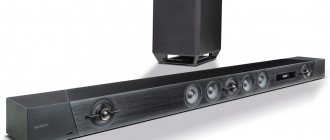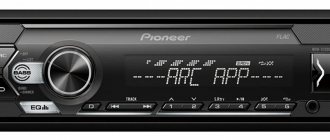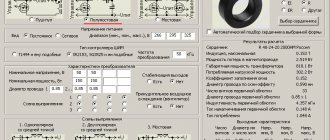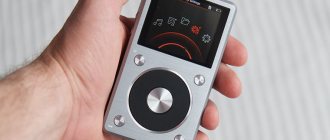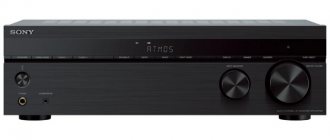Ever since the advent of the first smartphones, users have been concerned with a topic related to sound - how to make your device play music better? Many people buy players, external DACs for smartphones, or simply smartphones with good DACs. But all this gives an advantage only in bitrate and sampling frequency. In this article we will talk about the capabilities of different equalizers and the features of their settings.
The best Telegram channel about technology (possibly)
The best Telegram channel about technology (possibly)
Individual equalizers without ROOT
Wavelet
Often, equalizers only work with applications that play music—system sounds and audio streams from, for example, YouTube remain untouched. As far as I can remember, Wavelet is the only equalizer that does not require ROOT access, and at the same time allows you to apply settings to the entire system. To do this, you need to enable a special Legacy mode in the application. In addition, there is a convenient functionality for automatically switching profiles between audio devices from which sounds are played. Otherwise, the equalizer does not offer much variability, especially without unlocking all functions, which costs money - 329 rubles. But you shouldn’t be afraid of this, all the main functions are available in free mode: automatic equalization based on the models of different headphones and speakers, a 9-band graphic equalizer, a limiter and balance settings. In paid mode, a bass booster, virtualizer, reverb and bass tuner also become available.
Wavelet Features:
- the settings apply to the entire system;
- sufficient functionality for most in free mode;
- simple and intuitive interface;
- automatic profile switching for Bluetooth, speakers and headphones.
Poweramp Equalizer
Like the player of the same name, this equalizer has an incredible amount of functionality - here you can adjust almost every aspect of the sound, be it equalization, compression or sampling frequency. This equalizer is suitable for both the casual user and the audiophile. The interface, although convenient, is quite complex, although it is not difficult to get used to. On the first tab there is an equalizer and a limiter button, on the second there is a compressor and sound balance settings. In the settings, you can adjust parameters such as the number of equalizer bands (maximum - 31!) or the sampling frequency of the audio stream output, as well as many other, smaller functions. Unfortunately, all this is available only when paying for Premium access costing 150 rubles, and in the free version only the equalizer will be available to the user.
Poweramp equalizer features:
- a large amount of functionality when paying for Premium access;
- detailed configuration of the audio stream;
- 31-band equalizer;
- import and export of configured profiles.
4. Leave your voice - let him sing.
Voice, or as in the jargon of music producers, “vocals”. Vocals are also an integral part of the songs. It can be processed in all sorts of ways, but the most common procedure occurs on the equalizer. The frequency of the voice can range from 80 to 1100 Hz. It all depends on the voice, because every person speaks with his own voice. It can be tenor (120 - 500Hz) or soprano (230 - 1100Hz), there is also bass (80 - 330Hz) and mezzo-soprano (170 to 700Hz). Depending on the type of human voice, adjust the equalizer. If you are an ordinary listener and you are not going to go through the settings for a new song every time, then adjust the equalizer in the region of 200 - 800 Hz.
Individual equalizers with ROOT
Viper4Android
This equalizer is a real living legend among all Android equalizers. Ever since Android 2.3, this application has delighted users with a truly large amount of functionality and convenient operation. Like Wavelet, you can enable audio to be applied to the entire system, and it automatically switches profiles. In addition, the application has a huge amount of functionality, starting with a simple 10-band equalizer, and ending with a convolver (a function that allows you to apply pulses) and spectrum expansion (raising the bitrate with algorithms). Unfortunately, the main developers abandoned their creation a long time ago, so now on the latest versions of Android you have to be content with somehow working mods from enthusiasts.
Features of Viper4Android:
- a large amount of functionality, including atypical ones;
- the settings apply to the entire system.
JamesDSP
JamesDSP is conceived as a more modern and efficient analogue of Viper4Android. Essentially, this equalizer has almost the same functionality, with the exception of a few functions, such as spectrum expansion. At the same time, some of them are implemented better technically and their use causes less distortion of the audio stream in the end.
Features of JamesDSP:
- normal operation on the latest versions of Android;
- better implementation of functions than V4A.
6.Too quiet.
It happens that after adjustments, a song or sound may become much quieter. There are two options for returning the volume:
- A. The most common and simple way is to simply turn up the volume.
- B. A method that is more (best) and does not require wringing all the juices out of your system. It is enough to raise the overall sound band of the equalizer, but also do not overdo it, everything in moderation.
Good equalizers included in players
Stellio
Stellio is a good player with a nice flat interface. Surprisingly, in some sense its equalizer turned out to be even more powerful than the Poweramp described above, if we talk about adjusting the sound, and not the parameters of the audio stream. There is a 12-band equalizer, compressor, echo, reverb, flight effect and AutoWah. In addition, you can adjust the tone and speed of the recording being played. If necessary, you can turn off the equalizer and use a separate one. Unfortunately, you can remove ads and get exclusive themes for the player only by purchasing Premium access worth 200 rubles.
Features of Stellio equalizer:
- a large amount of functionality, including atypical ones.
JetAudio
If the previous player had a modern, pleasant interface, then jetAudio, alas, cannot please you with this. However, it has its advantages: at least, more stable operation and interesting functionality. For example, here you can enable audio output through the HRA engine, which allows you to play high-quality Hi-Res files. In addition, of course, there is an equalizer and many other functions, such as: reverb, compressor, AM3D sound amplifier, Bongiovi DPS (analogue of automatic equalization in Wavelet), Crystalizer. Unfortunately, only an equalizer with reverb and a compressor is available for free; the rest can be purchased as a package for 350 rubles (or obtained through Play Pass), or by purchasing the desired function separately, paying 260 rubles for each. You can also adjust the sound balance and enable auto-switching of profiles.
Features of jetAudio equalizer:
- presence of branded chips;
- automatic profile switching for Bluetooth, speakers and headphones.
2. Don't make noise!
It’s unlikely that anyone has noticed, but every modern music contains white noise. It happens in two cases:
- A. Poorly processed melody (sound).
- B. Panning the sound by adding noise. Simply put, it makes the sound more spacious.
There are three types of noise frequency:
- low frequency (less than 300Hz)
- mid-frequency (from 300 to 800Hz)
- High frequency (over 800Hz)
So, you decide whether this will be part of the sound or whether it is not needed at all. Therefore, when adjusting the equalizer, try to reduce it to a minimum if you think it creates an unnecessary effect, or look for a middle ground by lowering the high frequencies. But under no circumstances make it louder, it will be unpleasant for your ears!
Tips for adjusting the equalizer
Most users configure the equalizer in the form of a parabola: with high and low frequencies raised and the middle filled up. I did this too, until I realized a few simple rules: that too much amplification of any frequency will only lead to distortion of the final sound, but not to improvement, and also that the middle is actually an important component of any song.
Based on my personal experience of listening and mixing music, I have compiled a short “frequency guide” to help you figure out exactly how to set up your equalizer:
- ~75 Hz: kick drum and low, deep bass. Raising this frequency too much can lead to excessive sound compression and clipping (crackling). I usually increase it by 4-5 dB.
- ~150Hz: Mainly affects bass. Raising it too much can cause the bass to become boomy and unpleasant. Usually I don’t touch it, or I turn it down a couple of decibels.
- ~300-600 Hz: those frequencies where many instruments intersect, starting with the bass and ending with the voice. Raising it too much can cause an unpleasant hum, muddiness and “barreliness” in the sound, but you should remove these frequencies wisely - only if you clearly hear the problems described above.
- ~1.2-2.4 KHz: Mainly affects guitar and voice. In general, these are the very frequencies that should not be touched at all - usually there are enough of them in any headphones or speakers.
- ~4.8KHz: Upper mids, affects guitar. On some headphones, this and the next frequencies are raised specifically so that the listener seems as if the music is playing loudly, although this is not the case. On headphones, I mute this frequency by 3-5 dB, because otherwise the sound turns into mush without details and clarity, and also hurts the ears at high volumes. If you notice unpleasant pressure on your ears while listening to music from your smartphone's speakers at high volume, then muting this and the following frequencies will also help.
- ~9.6 KHz: Frequency responsible for the brightness of cymbals and hissing/whistling vocal sounds. As with the previous frequency, on headphones I recommend reducing this frequency by about 5 dB if you feel that at high volumes it hurts your ears and you cannot hear the instruments individually.
- ~12-19 KHz: frequencies in the range of which cymbals and other very high sounds are found. Unlike the previous two, these do not cause such problems, but simply emphasize the presence of tools. If there are not enough plates, you can raise it by 3-4 dB.
It is worth understanding that the same settings for different audio devices will not work - each of them has its own frequency response (amplitude-frequency response) and nuances for which individual sound needs to be adjusted. That’s why I highlighted automatic profile switching in particular - if in addition to headphones you have a speaker and/or good speakers in your smartphone, it’s better to set up separate profiles for them.
Be like a sculptor.
This saying puts it bluntly: “carve and be an artist.” That is, imagine yourself as a sculptor, in front of you is a stone block, you must knock out a sculpture from it, give it shape and volume.
The same goes for the sound or music that you are going to process. Just imagine that there is a stone in front of you, cut off unnecessary purities, these can be both low and high frequencies, but do not overdo it, otherwise your figure will turn out to be bare.

